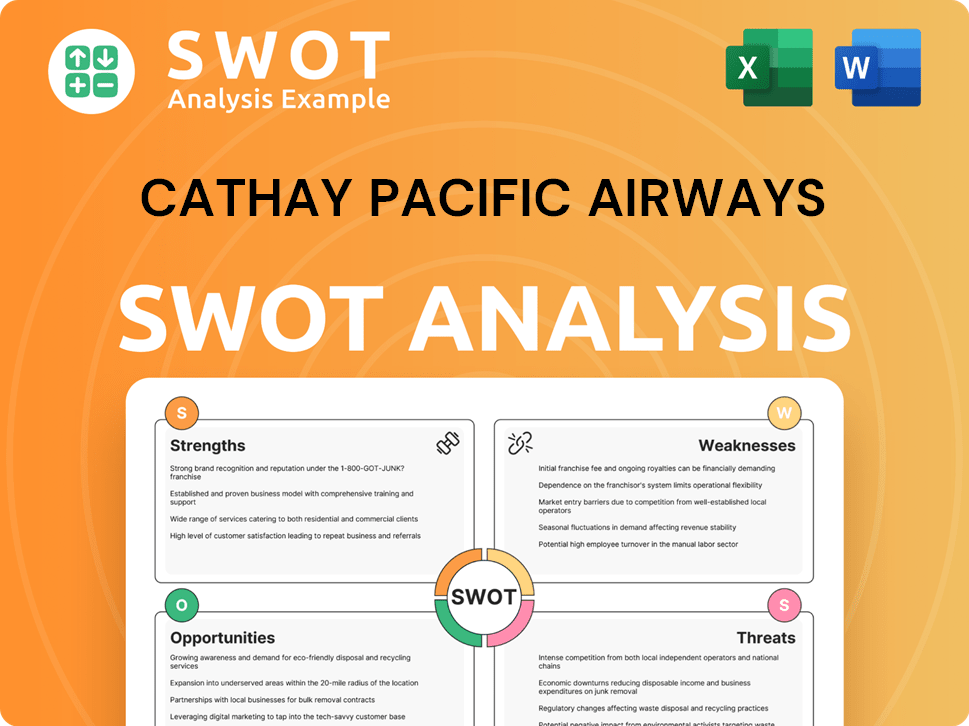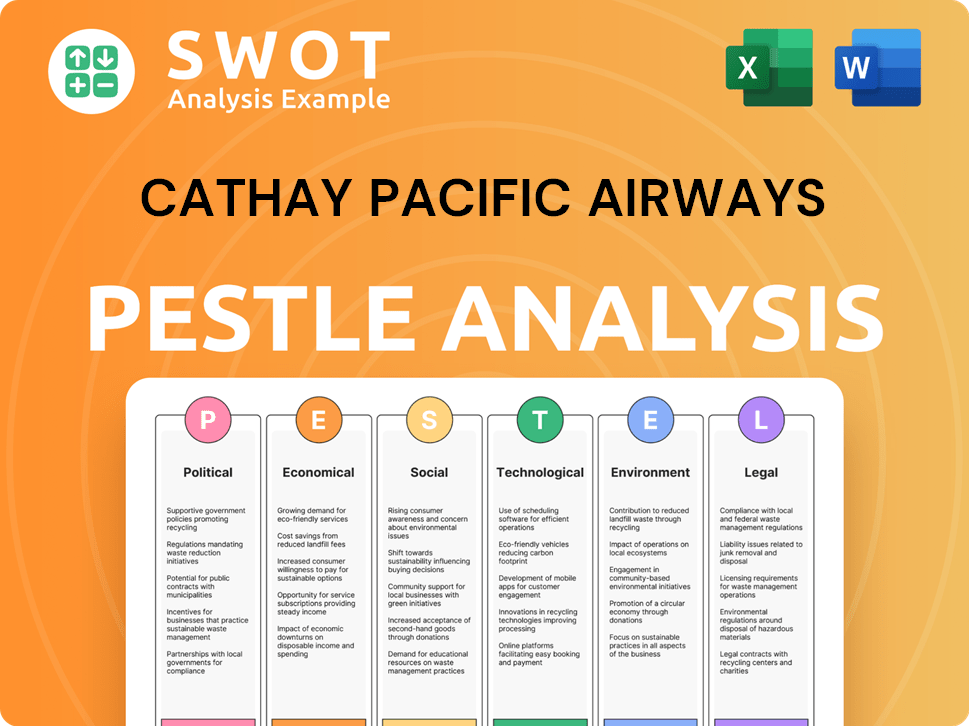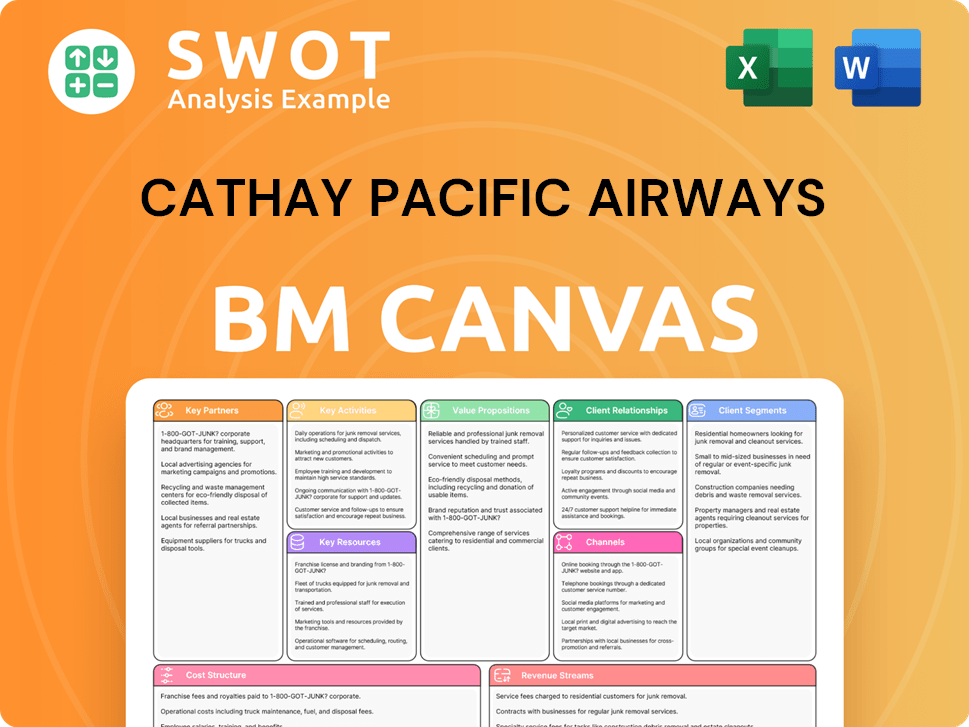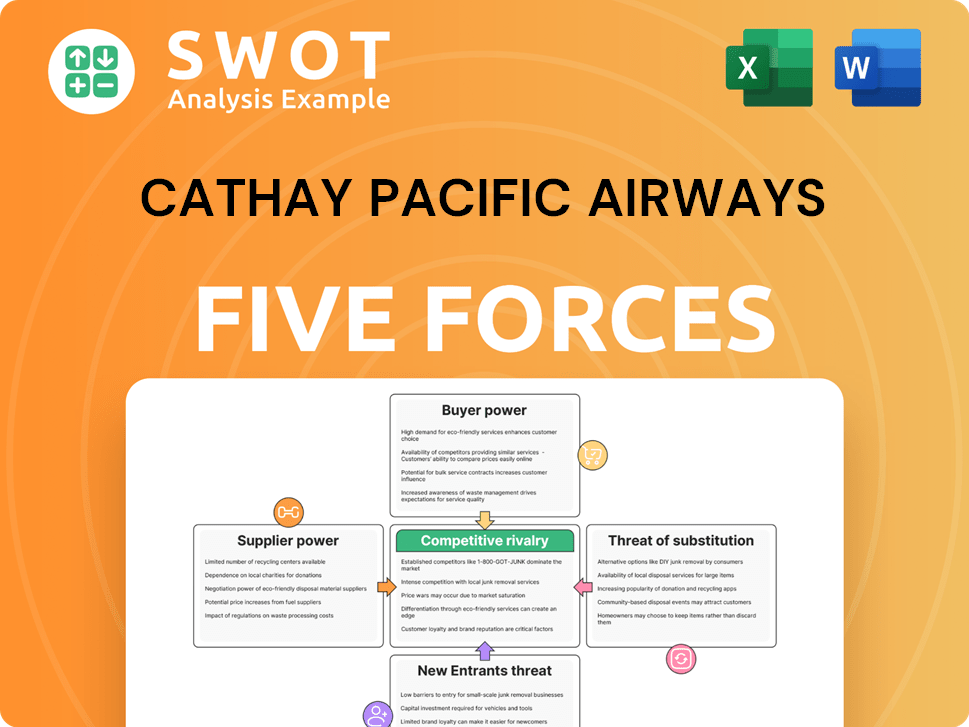Cathay Pacific Airways Bundle
Can Cathay Pacific Soar to New Heights?
Cathay Pacific Airways, a cornerstone of Hong Kong's aviation sector since 1946, is aggressively pursuing a growth strategy that promises to reshape its global footprint. With ambitious expansion plans targeting over 100 destinations by the end of 2025 and a HK$100 billion investment, the airline signals a decisive move to solidify its market leadership. This strategic pivot comes as Cathay Pacific aims to not only recover from past challenges but also to redefine its position within the competitive airline industry.

This article dives deep into Cathay Pacific's future prospects, analyzing its Cathay Pacific Airways SWOT Analysis and strategic initiatives. We'll explore how the airline is navigating the Hong Kong aviation market, adapting to industry challenges, and implementing operational efficiency strategies. By examining its expansion plans, financial performance review, and digital transformation strategy, we uncover the key drivers behind Cathay Pacific's long-term business goals and investment opportunities within the context of the current competitive landscape.
How Is Cathay Pacific Airways Expanding Its Reach?
Cathay Pacific Airways is actively pursuing a robust expansion strategy, driving its Cathay Pacific growth strategy. This involves entering new markets, increasing flight frequencies, and modernizing its fleet. The airline aims to serve over 100 destinations worldwide by 2025, a significant milestone in its Cathay Pacific future prospects.
The expansion includes adding 13 new destinations in 2025, such as Hyderabad, Dallas, Urumqi, Rome, Munich, and Brussels for Cathay Pacific, and Sendai, Nha Trang, Ishigaki, Komatsu, Cheongju, Daegu, and Miyako (Shimojishima) for HK Express. The new Dallas-Hong Kong service, launched on April 24, 2025, is a strategic milestone as Cathay Pacific's first major hub in the southern United States. Flights to Urumqi also commenced on April 28, 2025, bringing the airline's total mainland China destinations to 20.
Beyond new routes, both Cathay Pacific and HK Express are boosting flight frequencies on existing routes, particularly within mainland China. Flights are expected to increase by 40% this northern summer compared to last year, reaching almost 300 per week. This growth is fueled by strong travel demand, especially from mainland China, and the desire to bolster Hong Kong's position as a leading international aviation hub. To support this expansion, the Cathay Group is adding over 100 new passenger and freighter aircraft to its fleet in the coming years. For more information about the airline's customer base, you can read about the Target Market of Cathay Pacific Airways.
The airline is also focusing on fleet modernization and cargo capacity. While the first deliveries of Boeing 777-9s are not expected until the first quarter of 2027, Cathay Pacific is negotiating with Boeing and Airbus for more widebody orders and is reintroducing Airbus A330s to its fleet after cabin retrofits.
- Cathay Pacific plans to replace its entire fleet of Airbus A300-600F freighters with second-hand A330F freighters.
- The remaining three A300-600F freighters are expected to be returned in 2025.
- Cathay Cargo is shifting freighter capacity to high-demand routes like Anchorage to Miami and Hong Kong to Europe.
- A late 2024 partnership with NorthLink Aviation provides exclusive access to Anchorage's infrastructure.
Cathay Pacific Airways SWOT Analysis
- Complete SWOT Breakdown
- Fully Customizable
- Editable in Excel & Word
- Professional Formatting
- Investor-Ready Format

How Does Cathay Pacific Airways Invest in Innovation?
Cathay Pacific Airways is actively leveraging innovation and technology to drive its growth strategy and enhance its future prospects. This approach focuses on digital transformation, improving customer experiences, and implementing sustainability initiatives. The airline's strategic investments, totaling over HK$100 billion, are a testament to its commitment to these areas, positioning it for sustained success in the competitive airline industry.
The airline's focus on digital transformation and customer experience improvements is evident in its partnerships and product upgrades. These efforts are designed to streamline operations, enhance passenger comfort, and meet the evolving demands of the modern traveler. Through these initiatives, Cathay Pacific aims to maintain its competitive edge and strengthen its position in the Hong Kong aviation market.
Cathay Pacific's commitment to sustainability, including its Corporate Sustainable Aviation Fuel (SAF) Programme, is also a key element of its growth strategy. These initiatives demonstrate the airline's dedication to reducing its environmental impact and contributing to a more sustainable future for air travel, aligning with global trends and expectations.
Cathay Pacific is investing significantly in digital transformation to enhance operational efficiency and customer service. A key partnership with Trax, a provider of paperless aviation maintenance software, is driving this transformation. This strategic move aims to create a paperless environment, providing real-time data access for informed decision-making.
The airline is enhancing customer experience through technological advancements, including the Aria Suite in Business Class. This new product features fully enclosed suites, large screens, and integrated charging. A new First Class product is planned for 2025, and new flat-bed Business Class cabins are planned for the A330 fleet by 2026, enhancing the overall passenger experience.
Cathay Pacific is committed to sustainability through its Corporate Sustainable Aviation Fuel (SAF) Programme. The airline aims for 10% SAF usage by 2030. In 2024, Cathay Pacific used 3,400 metric tonnes of SAF from Hong Kong International Airport, and a new partnership secured 878 metric tonnes of SAF. The airline is also reducing single-use plastics.
In March 2025, Cathay Pacific selected Trax to power its Engineering Department's digital transformation. This involves using Trax's eMRO solution and eMobility applications for real-time, data-driven maintenance operations. This technology provides instant access to critical operational data, enhancing productivity and decision-making capabilities.
The introduction of the Aria Suite in Business Class showcases Cathay Pacific's commitment to premium passenger experiences. The new First Class product, set to debut on the Boeing 777-9 in 2025, and the planned upgrades to the A330 fleet by 2026, further enhance the airline's offerings. These upgrades are part of the company's long-term business goals.
Cathay Pacific's SAF Programme is a key part of its strategic planning. The airline's goal is to use 10% SAF by 2030. In 2024, the airline used 3,400 metric tonnes of SAF from Hong Kong International Airport, and a new partnership secured 878 metric tonnes of SAF. These initiatives support Cathay Pacific's sustainability initiatives.
These technological and sustainability initiatives are vital for Cathay Pacific's competitive landscape. The airline's focus on innovation is designed to improve operational efficiency, enhance customer satisfaction, and reduce its environmental footprint. As the airline industry evolves, these strategies will be essential for maintaining a strong market position and achieving long-term business goals. The airline's investments in technology and sustainability are key to its future prospects.
Cathay Pacific's innovation and technology strategy encompasses digital transformation, customer experience improvements, and sustainability initiatives. These efforts are supported by significant investments and strategic partnerships, positioning the airline for future growth.
- Digital Transformation: Partnership with Trax for paperless maintenance operations.
- Customer Experience: Launch of Aria Suite and plans for new First Class and Business Class cabins.
- Sustainability: Corporate SAF Programme and reduction of single-use plastics.
- Investment: Over HK$100 billion committed to digital and sustainability leadership.
- SAF Usage: 3,400 metric tonnes used in 2024, with a goal of 10% SAF by 2030.
- Single-Use Plastics: Reduction from 7.7 pieces per passenger in 2019 to 2.6 pieces by the end of 2024, with a target of 1.5 pieces by the end of 2025.
Cathay Pacific Airways PESTLE Analysis
- Covers All 6 PESTLE Categories
- No Research Needed – Save Hours of Work
- Built by Experts, Trusted by Consultants
- Instant Download, Ready to Use
- 100% Editable, Fully Customizable

What Is Cathay Pacific Airways’s Growth Forecast?
The financial outlook for Cathay Pacific Airways is robust, with a clear trajectory of growth underpinned by strategic investments and operational efficiencies. The airline's financial performance in 2024 reflects a strong recovery, driven by increased passenger and cargo demand, improved cost management, and favorable fuel prices. This positive trend sets a solid foundation for future expansion and sustained profitability.
Cathay Pacific's strategic initiatives and market positioning are designed to capitalize on the recovery of the aviation sector. The company's focus on capacity growth, particularly in passenger services, and its commitment to investing in new aircraft and digital enhancements are key drivers of its future prospects. The airline's ability to adapt to market dynamics and leverage opportunities in the Hong Kong aviation market will be crucial for its long-term success.
The Cathay Group reported an attributable profit of US$1.27 billion (HK$9.888 billion) for 2024, marking a significant financial milestone. Group revenue for the same period rose by 10.5% year-on-year to US$13.4 billion (HK$104.371 billion). This growth was fueled by a rise in passenger revenue, which increased by 11.9% to HK$62.5 billion, and cargo revenue, which increased by 8.3% to HK$24 billion. These figures highlight the airline's strong recovery and its ability to generate revenue across its passenger and cargo segments. For more detailed insights, you can read this article about Cathay Pacific Airways.
Cathay Pacific aims for significant capacity growth, targeting a second consecutive 30%-plus annual capacity increase in 2025. Passenger capacity is estimated to increase at a 9% compound annual growth rate (CAGR) over the next five years. This expansion is designed to meet growing demand and strengthen the airline's market position.
Total revenue is projected to rise at a five-year CAGR of 4% from 2024 to 2029. This growth is supported by increased capacity, enhanced operational efficiency, and a focus on customer experience. The airline's revenue projections reflect its confidence in its ability to sustain growth.
The operating margin is forecasted to reach 10.5% by 2029, supported by softer oil prices and improved cost management. This improvement in operating margin indicates the airline's ability to enhance profitability and manage its cost structure effectively. This is one of the key aspects of the Cathay Pacific growth strategy.
The airline is committed to investing over HK$100 billion in the coming years, coinciding with the commissioning of Hong Kong's Three-Runway System. These investments will be used to acquire new-generation aircraft, enhance cabin interiors and lounges, and implement digital innovations. These investments are crucial for the Cathay Pacific future prospects.
Cathay Pacific's financial health is demonstrated by its strong liquidity and strategic investments, positioning it well for future growth. The airline's commitment to operational efficiency and customer experience further supports its long-term goals.
- US$1.27 billion (HK$9.888 billion) attributable profit for 2024.
- 10.5% year-on-year increase in group revenue to US$13.4 billion (HK$104.371 billion) in 2024.
- 11.9% increase in passenger revenue to HK$62.5 billion.
- 8.3% increase in cargo revenue to HK$24 billion.
- HK$19,073 million available unrestricted liquidity balance as of December 31, 2024.
Cathay Pacific Airways Business Model Canvas
- Complete 9-Block Business Model Canvas
- Effortlessly Communicate Your Business Strategy
- Investor-Ready BMC Format
- 100% Editable and Customizable
- Clear and Structured Layout

What Risks Could Slow Cathay Pacific Airways’s Growth?
The path to growth for Cathay Pacific Airways is not without its obstacles. The airline faces several strategic and operational risks that could impact its ambitious goals. Understanding these challenges is crucial for assessing its future prospects and potential investment opportunities.
Market competition and external factors such as supply chain disruptions and geopolitical tensions pose significant threats. Internal resource constraints, like pilot shortages, further complicate the situation. These factors require careful strategic planning and proactive management to ensure sustainable growth.
To navigate these challenges, Cathay Pacific must implement robust mitigation strategies. This includes adapting to market dynamics, managing operational efficiencies, and addressing resource limitations. The airline's ability to adapt will determine its success in the competitive aviation market.
Intense competition, especially on regional routes, pressures passenger yields. The airline's reliance on international markets makes it vulnerable to global travel fluctuations. Before the pandemic, Cathay Pacific faced strong competition from Chinese airlines expanding internationally.
Supply chain issues continue to affect the aviation industry, potentially impacting Cathay Pacific in 2025 and beyond. Delays in deliveries and rising costs can affect operational efficiency and profitability. The airline must proactively manage its supply chain to mitigate these risks.
Geopolitical risks, such as trade conflicts, could significantly affect Cathay Cargo operations. Rising trade tensions between the US and China may reduce trans-Pacific cargo demand. For instance, US tariffs on Chinese goods could reach 20%, and reciprocal Chinese tariffs on agricultural exports could hit 15% by March 2025.
Pilot shortages and training bottlenecks can slow the airline's operational recovery. The global aviation industry faces a pilot shortfall, projected to reach up to 34,000 pilots by 2025. Regulatory and airspace protocols can also reduce operational efficiency and increase expenses.
Regulatory and airspace protocols can reduce operational efficiency and increase expenses. Operational efficiency is a key factor in controlling costs and maintaining competitiveness. Cathay Pacific must continuously seek ways to improve its operational processes.
Cathay Pacific is diversifying its cargo routes, shifting freighter capacity to high-demand areas. The airline is focused on maintaining 'safety and quality' in its operations. This strategy is crucial for navigating the challenges and ensuring long-term success.
The cargo business faces significant challenges due to geopolitical risks and trade tensions. Escalating US-China trade tensions could lead to a 10-15% decline in trans-Pacific cargo demand in 2025 compared to 2024. Analyst estimates suggest tariff-driven operational costs for carriers like Cathay could rise by 20-30%. The airline is adapting by diversifying routes and focusing on high-demand areas.
The global pilot shortage poses a significant threat to Cathay Pacific's growth plans. The industry-wide shortfall, projected at up to 34,000 pilots by 2025, can restrict capacity expansion and increase operational costs. Addressing this shortage through training and recruitment is critical for the airline's future. You can find more about the airline in the Brief History of Cathay Pacific Airways.
Cathay Pacific Airways Porter's Five Forces Analysis
- Covers All 5 Competitive Forces in Detail
- Structured for Consultants, Students, and Founders
- 100% Editable in Microsoft Word & Excel
- Instant Digital Download – Use Immediately
- Compatible with Mac & PC – Fully Unlocked

Related Blogs
- What are Mission Vision & Core Values of Cathay Pacific Airways Company?
- What is Competitive Landscape of Cathay Pacific Airways Company?
- How Does Cathay Pacific Airways Company Work?
- What is Sales and Marketing Strategy of Cathay Pacific Airways Company?
- What is Brief History of Cathay Pacific Airways Company?
- Who Owns Cathay Pacific Airways Company?
- What is Customer Demographics and Target Market of Cathay Pacific Airways Company?
Disclaimer
All information, articles, and product details provided on this website are for general informational and educational purposes only. We do not claim any ownership over, nor do we intend to infringe upon, any trademarks, copyrights, logos, brand names, or other intellectual property mentioned or depicted on this site. Such intellectual property remains the property of its respective owners, and any references here are made solely for identification or informational purposes, without implying any affiliation, endorsement, or partnership.
We make no representations or warranties, express or implied, regarding the accuracy, completeness, or suitability of any content or products presented. Nothing on this website should be construed as legal, tax, investment, financial, medical, or other professional advice. In addition, no part of this site—including articles or product references—constitutes a solicitation, recommendation, endorsement, advertisement, or offer to buy or sell any securities, franchises, or other financial instruments, particularly in jurisdictions where such activity would be unlawful.
All content is of a general nature and may not address the specific circumstances of any individual or entity. It is not a substitute for professional advice or services. Any actions you take based on the information provided here are strictly at your own risk. You accept full responsibility for any decisions or outcomes arising from your use of this website and agree to release us from any liability in connection with your use of, or reliance upon, the content or products found herein.